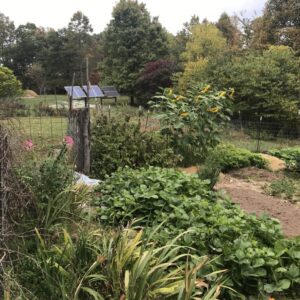A version of this column first ran in the Roane County (WV) Reporter and Times Record. Support local journalism! Subscribe to your local newspaper.
 As I write this, the forecast is for potential frost tonight. Since my garden is on the ridge, but not quite the highest point locally, it may well escape the frost even if other spots are hit. Nonetheless, I will cover some things. This is worth doing because according to the forecast—I use the ten day forecast from weatherunderground.com—we’ll have warmer weather for the next week. If it was supposed to keep potentially frosting, I’d pull or dig everything sensitive.
As I write this, the forecast is for potential frost tonight. Since my garden is on the ridge, but not quite the highest point locally, it may well escape the frost even if other spots are hit. Nonetheless, I will cover some things. This is worth doing because according to the forecast—I use the ten day forecast from weatherunderground.com—we’ll have warmer weather for the next week. If it was supposed to keep potentially frosting, I’d pull or dig everything sensitive.
I won’t be able to cover everything. I have several old sheets in my garden shed, and plant pots and buckets, and a tarp. But obviously I can’t cover the late sunflowers, which are now eight feet tall and have hanging heads full of burgeoning chicken food. I thought they weren’t going to mature before frost but they’re making fine progress.
There is a bed of dry beans, a purple variety from Africa called Kebarika. The pods are full size and the plants are beginning to yellow, but the pods are still green so I’ll cover them in hopes of their getting to the dry stage before harvest. I already pulled all my peanuts, so I could hang them in my greenhouse to dry and get them plucked and cleared out in time for the beans to hang there. And I have a bed of cowpeas (AKA southern peas or black-eyed peas) but I won’t bother covering them because they’re just starting to flower, so they surely won’t manage to mature peas—I’ll just let them die and lie on the bed as a winter cover.
I also have a fence full of purple snap beans, which have been remarkably productive. They shelter a ginger plant—I had two but have already harvested one. Here is a quandary, because this plant has a fat bud on top, ready to bloom if it can stand the cold. And it previously bloomed—sexy white blooms of an orchid type, and fragrant. Well, I could refer to “fragrance” or “scent” if I want to imply some delicacy, but the truth is this is a lily-like scent, and if you grow lilies you know that even one in a vase in the house will cause any male persons present to make remarks about French houses of ill repute, even if they have never been to France and don’t know what they’re talking about.
That bed also has one of two roselle plants. This is a three foot tall hibiscus, which makes cream colored flowers; it’s the dark red calices that are edible, in zinger teas and in a substitute for cranberries in relish. I want to try that this Thanksgiving if I can harvest enough of these. That will be covered with this bed, but I’ll need a separate cover for the other one in the flower strip.
Then there are two beds of peppers. I don’t care about the green peppers, which have been so full of disease they are only now producing a second fruit. But the hot peppers are fairly productive despite the disease, especially the habaneros. I have two of those, barely touched by the disease and pumping out those dangling orange lanterns which shed such warm light. I’ll cover the hot peppers.
I’ll dig the rest of the sweet potatoes this afternoon, because along with being tender, I found when I dug some yesterday that the orange ones which remain have been chewed upon, so I need to rescue them from whatever varmint is making all those holes in them.
I won’t try to cover the raspberries, which are slowing down anyway and I am having to share them with yellow jackets. I don’t begrudge the yellow jackets, as I am getting a bumper crop and have trouble using or giving them all away.
That leaves flowers. In my flowerbed I need to dig up the tuberoses to store for the winter—I also have a dahlia in the flowering strip at the top of my main garden, but I hate to dig that as it is finally making lots of flowers, which figure largely in my bouquets currently. I’d better cover it. I should probably collect seeds from the marigolds—I already got some from the cosmos. I won’t cover them.
Other crops you may want to cover include tomatoes, squash, cucumbers, and melons. If you don’t cover things, and it does frost, you still may be able to save plants if the air temperature is above freezing before the sun hits the plant, by watering it; lukewarm water will thaw the plant, and it’s when sun hits frozen vegetation that the real damage happens.
Use the comment section for questions, objections and suggestions.
